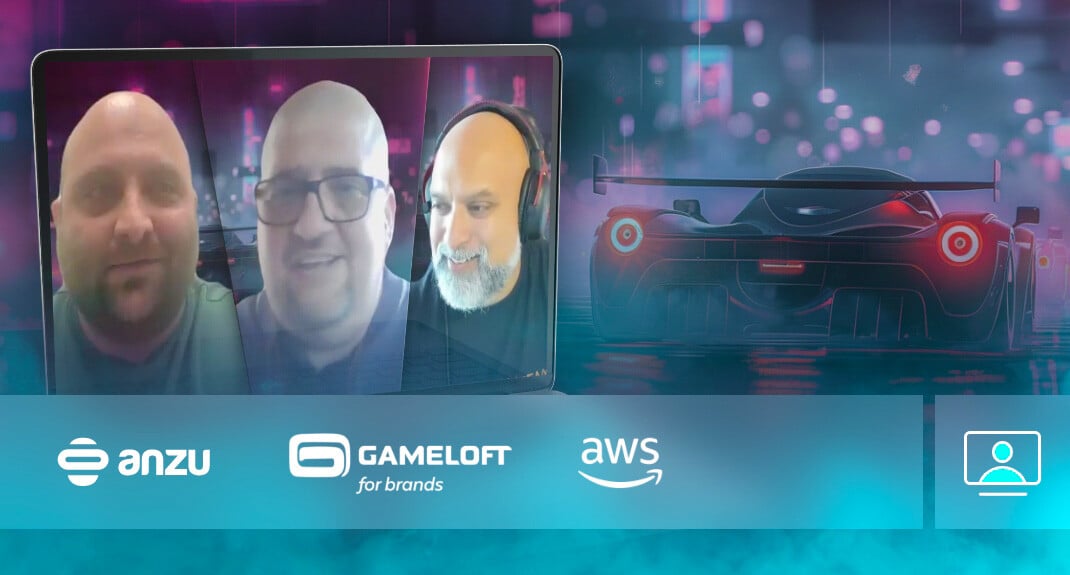- Newsroom
- >
- How Intrinsic In-Game Ads Are Making Virtual Worlds Feel More Real

How Intrinsic In-Game Ads Are Making Virtual Worlds Feel More Real
With game development costs continuing to rise and players expecting increasingly immersive and seamless gaming experiences without large price tags, developers everywhere are having to experiment with different monetization solutions to fuel growth and expansion.
In a recent webinar, George Iosif, Ads Monetization Manager at Gameloft, one of the globe’s leading international video game developers and publishers, and Maor Wurembrand, Director of Growth Management at Anzu, shared insights with Shayan Sanyal, Global Games Industry BD Leader at AWS. They explored how their partnership is using ads to drive new revenue streams and make game worlds more immersive by blending real and relevant ads into the player experience.
Striking The Perfect Balance
George shared his experience of how the ads have impacted player immersion early on in the conversation, noting that they initially started trialing intrinsic in-game ads in Gangstar Vegas. In this open-world action-adventure game, players assume the role of a mixed martial arts fighter who becomes involved in a conflict with the mafia. George noted that with the game set in modern-day Las Vegas, it presented them with a great opportunity to test out intrinsic in-game ad placements, which can be placed in areas of the city you’d expect to find ads in the real world, like on bus stops, on roadside billboards, and on the sides of buildings.
 Intrinsic in-game ad for Disney+ in Gangstar Vegas
Intrinsic in-game ad for Disney+ in Gangstar Vegas
“When we first implemented these ads, we weren’t sure how our community would react,” George noted. “As soon as we set the placements live, ads from real-world brands started appearing for players to see as they ran around the city and completed quests and missions, and the feedback we received was overwhelmingly positive.”
“I distinctly remember one player who contacted customer care, and this is real, saying how much he loves the ads and how much they make the city feel real because they mirror ads he’d seen in real life. In real-world cities, you’re surrounded by ads every day; they’re all around you. For him, this immersion made the game more realistic. I was surprised by this comment, and it really stuck with me and helped me understand something very simple about intrinsic ads. Generally speaking, if you implement them properly, they can bring you so much value on multiple levels.”
Thanks to the success of the ad placements in Gangstar Vegas, Gameloft went on to implement them into their flagship racing title, Asphalt 9, where they were positioned alongside and over the racetracks, as well as on the sides of buildings. George noted that a lot of important work was done behind the scenes to understand where these ads should best sit.
 Intrinsic in-game ad for Sony in Asphalt 9
Intrinsic in-game ad for Sony in Asphalt 9
“When you approach monetization you must look at both the results you want to achieve and the way you’re going to go about achieving them. There’s a fine balance that needs to be maintained and a lot of trials and testing that must go on to ensure you get this right. I play a lot of games, and it’s clear that some developers are doing monetization better than others. To assure your growth and maintain player satisfaction, you must do your homework and understand how these monetization methods work both in isolation and together, especially if you have multiple monetization methods running simultaneously.”
Expanding Outside Of Mobile
Gameloft started as a mobile-first company but has recently seen success in creating and adapting its titles to other platforms, including console and PC. On the webinar, George spoke about bringing intrinsic in-game ads to titles outside of the mobile ecosystem and how they’ve learned how the ads worked on the mobile versions and are applying them to console and PC. One of the main challenges he mentioned was that there’s not as much demand across these channels as on mobile, partly due to advertisers being more used to the gaming mobile ecosystem because ads have existed in these games for a long time.
However, more and more brands are looking to PC and consoles to reach players, especially younger generations who are no longer reachable via traditional media like broadcast TV. This presents a massive opportunity for PC and console developers as they can offer brands premium real estate on the biggest screens in the home. George echoed his earlier point here that, above everything else, you should prioritize striking the right balance between player immersion and generating revenue, especially across gaming platforms where players have not traditionally seen ads in the past.
To hear the conversation in full, head here or sign up here to start monetizing with in-game ads today.

Nick is Anzu's Content Lead. As a gamer with a background in AdTech, he has a unique perspective on the industry and the in-game advertising sector.